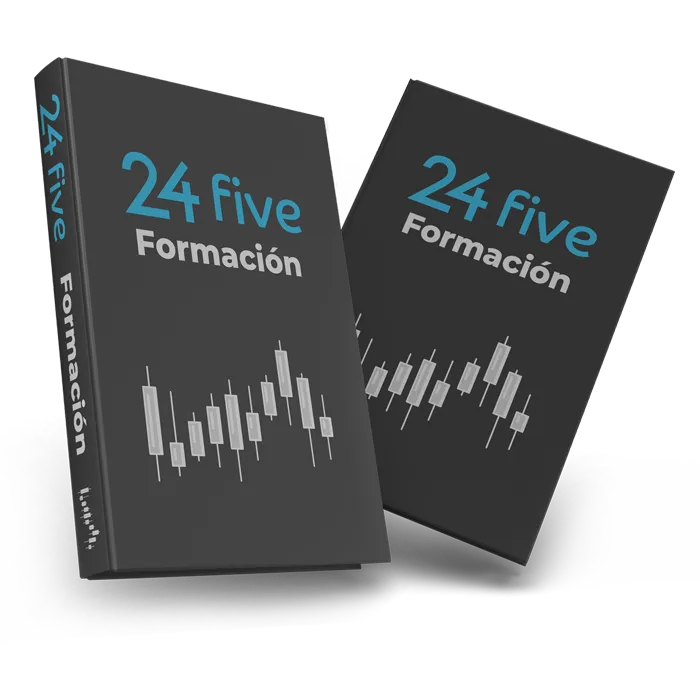Trading Risk Management
What is risk management in trading?
This guide, explains the importance of this fundamental process to succeed in the financial markets. At 24Five, we understand that online trading can initially seem challenging but with the right information and tools, anyone can become a successful trader.

Risk management as a key factor for success in Forex and CFD trading
Forex and Contracts for Difference (CFDs) trading is done using leverage, which allows traders to manage larger positions with a smaller initial deposit. While leverage can significantly increase potential gains, it also amplifies potential losses, greatly increasing the risks associated with trading.
In addition to leverage, there are many other risks in Forex and CFD trading. However, traders can take several steps to minimize these risks as much as possible. In this article, we will guide you through the basics of risk management in Forex and CFD trading, highlighting not only its importance, but also offering practical ways to implement effective risk management strategies.
Before you start trading in the real markets with Forex or CFDs, we recommend the following:
- Read this comprehensive guide to learn more about Forex and CFD risk management.
- Practice on our risk-free demo account.
- Explore the Education section on our website to clarify key concepts and get a clear guide on how to trade with 24Five.
What is Risk Management in Trading?
Risk management in trading refers to the set of strategies and practices that traders employ to identify, assess, and mitigate the financial risks associated with their market operations.
This approach seeks to limit potential losses and protect the trader’s capital by ensuring that no single trade has a disproportionate impact on the trading account.
Risk management includes techniques such as portfolio diversification, the use of stop-loss and take-profit orders, adjusting position sizes according to available capital, and understanding and controlling leverage. The main objective is to maintain a balance between maximizing profits and minimizing losses, which is essential for long-term sustainability in trading.
We can identify four key stages in any risk management strategy in trading:
- Risk identification: The first step in risk management is to recognize and catalog potential hazards that could affect trading. This includes risks related to market volatility, unexpected economic events, asset liquidity, and the use of leverage, among others.
- Risk analysis: Once risks have been identified, it is essential to analyze them to understand their magnitude and probability. This analysis allows traders to evaluate how each risk could impact their investments and what is the total exposure of the portfolio to those risks. This stage may involve the use of analytical tools, predictive models, and the review of historical data.
- Finding solutions to minimize risks: After analyzing the risks, it is necessary to develop strategies to mitigate them. These solutions may include diversifying the portfolio, implementing stop-loss orders, adjusting position sizes, or reducing the level of leverage. The goal is to find effective ways to limit the negative impact of the identified risks.
- Consistent management and application of these solutions: The last stage is the consistent application of the solutions found. Risk management is not a static process, but a dynamic one, which means that strategies must be regularly adjusted and applied according to market conditions and portfolio evolution. Discipline in the implementation of these strategies is essential to keep risk exposure within acceptable levels.
These four stages form a continuous cycle that must be integrated into the overall trading approach to ensure effective and sustainable risk management. In 24Five’s trading platform, you will find many tools to control and mitigate the risk of your trading operations.

Most common trading risks
Leverage
Leverage is a powerful tool that can greatly increase profit opportunities, but it also involves high risk, as losses are also amplified. Therefore, traders need to understand how leverage works and use it prudently, to prevent the risk from exceeding their ability to bear losses.
Leverage is a financial mechanism that allows traders to trade with a larger amount of money than the capital they possess. In essence, it is like borrowing money to invest, giving the trader the ability to control a larger position in the market with a relatively small initial investment.
Inaccurate Market Assessment
Inaccurate market assessment refers to a situation where a trader or investor makes an incorrect or incomplete analysis of market conditions, leading to wrong trading decisions. This may include underestimating volatility, misinterpreting trends, failing to properly consider macroeconomic factors, or ignoring key signals that could indicate a change in market direction.
Incorrect market assessment can result in taking positions that are not aligned with market reality, thereby increasing the risk of significant losses. This is why it is crucial to conduct detailed analysis and use reliable tools and data to assess the market before making investment decisions. In addition, traders must be prepared to adjust their strategies based on new information or changes in market conditions.
Rapid market movements
Rapid market movements pose a significant risk to traders as they can lead to abrupt changes in asset prices in a matter of seconds. These movements, often driven by unexpected news, economic announcements, political events, or changes in market perception, can cause prices to skyrocket or fall dramatically.
The primary risk of rapid market movements is that they can cause a trader’s positions to quickly become unfavorable before there is time to react appropriately. For example, if the market moves rapidly against a position, losses can quickly accumulate, especially if leverage is being used.
In addition, during times of high volatility, order execution can be affected, resulting in slippage or stop-loss orders not being filled at the expected level, which can further increase losses.
Two examples of situations that can cause these market movements are:
- The announcement of an increase in interest rates by the US central bank, or any central bank of economic powers.
- Huge volume purchases by investment funds cause market disruptions.
Market Gaps
Market gaps, also known as “gaps,” are significant differences between the closing price of an asset in one trading session and its opening price in the next session. These gaps usually occur when there are important events that affect the market outside of normal trading hours, such as economic announcements, corporate news, or geopolitical events.
There are several types of market gaps:
Breakaway gap: This occurs at the start of a new trend, when the price breaks through a significant support or resistance level, generating a gap that indicates strong momentum in a new direction.
Continuation gap: Also known as a “breakaway gap,” this gap occurs in the middle of an already established trend, signaling that the trend’s momentum remains strong.
Exhaustion gap: This occurs at the end of a trend, indicating that the movement is losing strength and that a change in direction could be near.
Market gaps represent risks and opportunities for traders. They can be difficult to predict and manage, as prices can move significantly without offering the possibility of reacting in real-time. To manage this risk, traders should be alert to factors that could cause gaps and consider adjusting their risk management strategies, such as using wider stop-loss orders or reducing position sizes ahead of events that may trigger these sharp moves.

Risk Management Tools
Stop Loss
A stop-loss is an order that a trader places on a trading platform to sell an asset when its price reaches a specific level, with the objective of limiting losses on a trade. This order acts as a risk management tool, helping to protect a trader’s capital by automatically closing a position if the market moves against their expectations.
How it works:
Choosing the right stop loss depends on many factors and there is no one rule that works for everyone, it will depend on the level of expected profit, the level of risk accepted by the trader and the trading opportunity. The following questions can guide you to help set the right stop loss for you
- What is the time frame of the trade?
- What is the target price and when do you expect to reach it?
- What is your account size and current balance?
- Do you already have any open positions?
- Does the order size match the account size, balance, time frame and current market situation?
- What is the general market sentiment (e.g., volatile, nervous, waiting for other news)?
- How long will this market remain open?
- Is the weekend approaching or is the market closed overnight?
In essence the trader decides the price at which he wants the sale to be executed in case the market moves against his position. This level is usually based on a percentage of the invested capital or a technical level of support or resistance.
Practical example: if a trader buys a stock at $100 and sets a stop-loss at $90, the stock will automatically sell if its price falls to $90. This limits the maximum loss to $10 per share, protecting the trader from further losses if the price continues to fall.
Types of stop-loss:
Fixed stop-loss: A specific price level is set and the order is executed when the asset reaches that price.
Dynamic stop-loss (trailing stop-loss): Allows the stop-loss level to be adjusted as the asset price moves in the trader’s favor, ensuring profits while protecting against adverse changes in the market.
Order Size
In the context of risk management refers to the number of units of an asset that a trader decides to buy or sell in a trade. Determining the appropriate order size is a crucial part of risk management as it directly impacts the risk and reward potential of each trade.
How is order size defined?
Assessing Available Capital: Order size should be in proportion to the total capital available in the trading account. Traders should ensure that they do not risk an excessive portion of their capital on a single trade.
Per Trade Risk Management: Traders typically set a specific percentage of capital that they are willing to risk on each trade (e.g. 1-2% of total capital). Order size is adjusted based on this percentage and the stop-loss level to ensure that potential losses remain within acceptable limits.
Order Size Calculation: To calculate order size, the stop-loss level and the amount the trader is willing to lose are considered.
The general formula is:
Order Size = Amount to Risk / Stop Loss Distance
Where:
Amount to Risk is the capital that one is willing to lose on the trade.
Stop-loss distance is the difference between the entry price and the stop-loss level.
Volatility Adjustments: In more volatile markets, order size adjustments may be needed to reflect larger fluctuations in price. Traders may choose to reduce order size in highly volatile environments to keep risk under control.
Diversification: Order size should also consider portfolio diversification. Trading too large order sizes in a single asset can concentrate risk while spreading capital across multiple positions can help mitigate this risk.
Choosing the right leverage level
The process of choosing the right leverage level in online trading risk management involves several critical steps to ensure that the leverage used is appropriate to the trader’s risk profile and market conditions. Here is the process:
Evaluating the Trader’s Risk Profile
Knowledge and Experience: Evaluating the trader’s level of experience is crucial. Novice traders can benefit from using lower leverages to minimize risk, while experienced traders can handle higher levels of leverage, as long as they properly understand and manage the associated risks.
Risk Tolerance: Determine how much risk the trader is willing to take. A high-risk tolerance may lead to using higher leverage, while a low tolerance suggests opting for lower leverage to protect capital.
Market Volatility Analysis
Evaluate Volatility: Analyze the volatility of the asset or market in which you are going to trade. In highly volatile markets, high leverage can amplify losses quickly. In such cases, it is advisable to use lower leverage to better manage risk.
Position Size Calculation
Before deciding on the leverage level, calculate the order size based on the available capital and risk per trade. This helps to establish how much leverage is necessary to achieve investment objectives without compromising risk.

Overview
The Forex and CFDmarketstoffers many opportunities to make profitsinn both long and short positions, butthey can also lead to large losses if effective risk management is not applied. It is crucial to identify and properly manage your weaknesses in order to limit losses, as a single loss can wipe out all the profits made, even if you have won on most trades.
The psychological impact of losses can be daunting for beginners, but it is important to accept that losses are an inevitable part of trading. Rather than focusing on losses, it is crucial to learn from them and psychologically prepare yourself to handle them.
This article provides an overview of risk management in trading, offering explanations and measures to counteract general risks in Forex and CFDs. Although financial advice is not provided, it is recommended that you use this information to improve your personal risk management. Remember that while you can limit risks, it is not possible to eliminate them completely. Refining and consistently applying appropriate risk management strategies can significantly improve your win-loss ratio for successful trading.
If you want to start your trading journey safely and reliably, register and contact one of our experts and start investing today.
